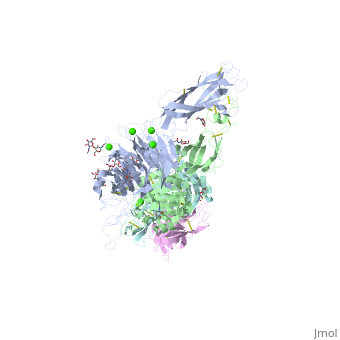Molecular Playground/IntegrinBeta1
One of the CBI Molecules being studied in the University of Massachusetts Amherst Chemistry-Biology Interface Program at UMass Amherst and on display at the Molecular Playground. Molecular Playground banner: "
Banner: Cancer cell migration, Integrin Beta 1 binds to ECM proteins and allows for 3D in vitro cell migration
|
StructureStructure
FunctionFunction
Integrins are a class of surface proteins that bind to extracellular matrix components and transmit chemical and mechanical cues to internal signaling pathways. Integrin beta 1 binds many proteins when dimerized with an alpha subunit, including collagen, laminin and fibronectin. Integrin adhesion to the extra cellular matrix is key for cell ability to adhere, migrate and proliferate in both 2D and 3D systems. These will eventually form adhesion complexes, which regulate actomyocin polymerization. During migration, cells continually form new focal adhesions at the leading edge of the cell and release adhesion complexes at the back of the cell, enabling forward movement.
Here are the N-acetyl-D-glucosamine may regulate integrin signaling during cancer cell migration.[1]
Integrins and cancerIntegrins and cancer
Integrins binding to the extracellular matrix provide cells with the traction to migrate and regulates their ability to remodel the extracellular matrix. For these reasons, integrins are extremely important in cancer metastasis, and the progression of solid tumors; which often stiffens from ECM remodeling [,]. When cells bind to extracellular matrix proteins with integrins, these proteins can stimulate survival, migration/invasion, and proliferation. Integrins are over expressed in cancer, but targeting integrins to treat cancer has seen limited success. Likely, these failures stem from differential integrin expression between cancer cells, and new technologies to screen cancer cell populations are being developed to screen for affective therapies []. Hopefully these technologies will allow for more selective treatment and better clinical efficacy for integrin inhibitors.
Studying Integrin Beta-1 in vitroStudying Integrin Beta-1 in vitro
Peyton Lab Research InterestsPeyton Lab Research Interests
The Peyton lab studies how cells process chemical and physical cues from the extracellular matrix and how these interactions play a role in the progression of cardiovascular disease and cancer. We aim to understand the downstream signaling pathways activated when cells use their integrins to bind to matrix and how this translates to the disease of interest.
ReferencesReferences
[1] C. Saravanan, F. Liu, I.K. Gipson and N. Panjwani1. Galectin-3 promotes lamellipodia formation in epithelial cells by interacting with complex N-glycans on 31 integrin. Journal of Cell Science 122, 3684-3693 Published by The Company of Biologists (2009). doi:10.1242/jcs.045674.
